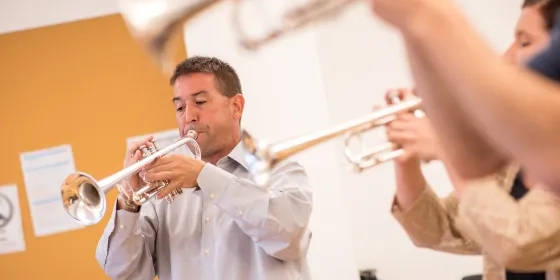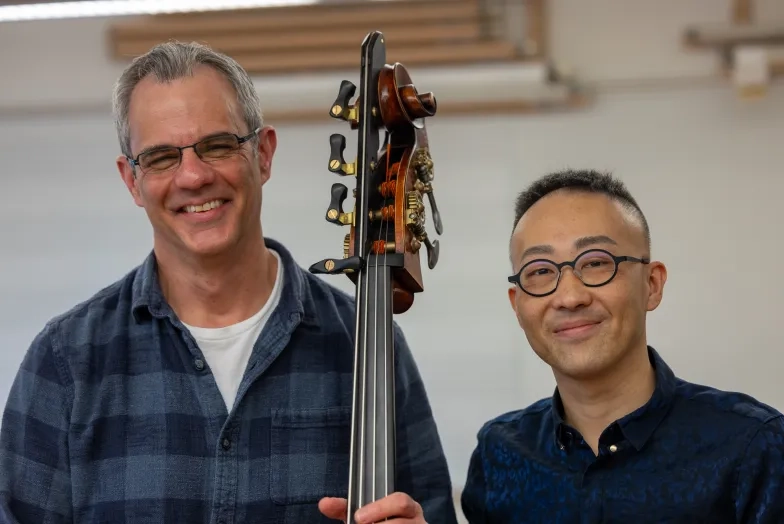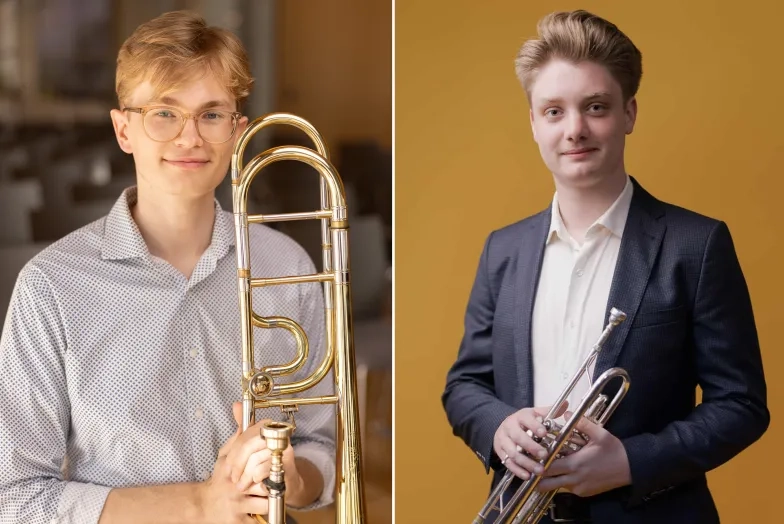SFCM Faculty on Why Music Education is Essential for Everyone
Music is an integral part of students’ education, or it should be. Just ask any of the dozen or so SFCM faculty attending the California All-State Music Education Conference (CASMEC), February 15–17 in San Jose. The group of faculty, mostly San Francisco Symphony members (including 6 principals), will travel to San Jose to lead an evening of master classes, following a full day at the Symphony and teaching at the San Francisco Conservatory of Music. This conference sets out to deliver and promote access to quality music education for all students, a value SFCM has long championed.
“It is such a wonderful opportunity and honor for SFCM to bring this group of our faculty, most of whom play at the San Francisco Symphony, to present an evening of master classes,” says Melissa Cocco-Mitten, Associate Dean of Admission at SFCM. “Many of the young musicians at CASMEC will take different paths, but those who choose to study music will be some of our most sought-after applicants. It is a rare opportunity to have so many of our best young musicians in one place, to be able to share the high-level artistry that infuses an SFCM education with them, and to experience these seasoned artists mentoring the next generation.”
Some of the faculty members who were in All-State when they were in high school are glad they are participating in these master classes now—something not offered to them when they were younger. “As a former All-State California Honor Band member way back in the late ‘80s, having Symphony musicians give master classes would have been an incredibly valuable musical experience," says Mark Inouye, SFCM trumpet faculty and principal trumpet of the San Francisco Symphony. “It will be great to come back 25 years later and not only witness it in these young musicians, but to feel it again myself!”
Timothy Higgins, trombone faculty at SFCM and principal trombone with the San Francisco Symphony, will be attending the conference and recalls the importance of his mentors during his formative years. “My college teacher, Michael Mulcahey opened my eyes to the passion and message music can bring to an audience.” Without this experience, Higgins would not be where he is today.
Now a seasoned performer and educator, Higgins takes his own passion for music and imparts it upon the next generation. For him, teaching is not only a skill but also an art. “Each student is different, and it is the teacher’s job to help guide the student through the process of discovering their sound and expression.” It’s not necessarily about reaching a certain level of musicianship, but rather, developing each student as individual players, capable of exploring music on their own. “Students develop at different rates and have varying strengths and weaknesses. Teachers need to be able to adapt to each student and guide them to the ultimate goal of being able to teach themselves.”
Scott Pingel, bass faculty at SFCM and principal bass with the San Francisco Symphony, will also attend the conference and finds the process of teaching an especially rewarding way to connect with the next generation of musicians. He also values teaching as a vehicle for self-reflection. “I have always loved teaching. I find it to be a fascinating journey of learning about another human being, the process of making music, and also myself.”
Pingel recalls his own teachers and the awe he felt when they played a particular passage of music for him. “Hearing them play in lessons was an absolute inspiration,” he says. Pingel grew up learning the value of self-discipline. His teachers would play and he would go into the practice room and wrestle with the music until he found the right sound.
As an educator, Pingel guides his own students as they wrestle to find their own sounds. “When I began teaching, there were so many things that I could do as a performer, but I didn't consciously know how I did them,” he recalls. “I had more of a kinesthetic competency than a theoretical one. As I gained more experience teaching, I realized that I would need to develop a deeper theoretical understanding so that the ‘how’ of efficient playing could be transferred more effectively to a greater range of students.”
Like Higgins, Pingel believes in training students to ultimately become self-sufficient. Letting them work through music to find their sound is fundamental to forming musicians with unique voices and ideas. “I do expect a lot from my students,” says Pingel. “But it isn’t any more than I would expect of myself.”
For Jerome Simas, clarinet faculty at SFCM and clarinetist with the San Francisco Symphony, teaching at CASMEC has special meaning—like Mark Inouye, he is a California All-State alumnus. “Some of my fondest memories growing up as a musician were as a participant in the honor bands here in California,” says Simas. He returns to where he was once a student to guide promising young musicians in their own musical journeys.
When reflecting on his approach to teaching, Simas notes, “It is important to stress fundamentals. With a solid foundation of technique, the goal is to ultimately rise beyond the printed page.” Although the music is spelled out note for note, Simas believes in a student’s musical independence. “It is as important to look for ways to solve problems as it is to look for ways to be spontaneous.”
The passion and spontaneity of a young musicians is one of the most exciting things a teacher can be a part of. “Watching them discover a great piece of music,” says Higgins, “can be very inspiring to witness.” Pingel notes that choosing a piece for a student can be as difficult as learning it. “I know I learn best when I’m emotionally invested in, and inspired by, the piece I am learning.” He tries to achieve the same for each student. The work must be didactic, practical, and musically rewarding, and for each student this means something different.
Learning the repertoire and performing it is what connects musicians to the entire history of music and performance, to their teachers, and to their teacher’s teachers. As he reflects on the centuries-long tradition of classical music, Higgins cannot help but note the link between past, present, and future in every lesson he teaches and every concert he plays. “In classical music, we are communicating the unique combination of sound traditions each of have been taught. It is vital for our art from to be able to educate the next generation of players in this great lineage.”
Simas, in turn, recalls the lessons he learns on stage and uses them to teach his students. “It’s great to impart my years of experience on the stage to the professional musicians of the future.” The two, teacher and performer, are intertwined. Communicating music can happen on stage and in the classroom, and for Simas, his students are a source of constant inspiration.
From connecting with other people to becoming a part of this great lineage, music education is an invaluable experience for both student and teacher. The discipline, concentration, and patience required on both sides makes teaching and learning music a deeply formative experience. “It is one of the most noble things one can do,” notes Pingel. “Sharing one’s accumulated knowledge and wisdom with a young person is a beautiful act.”
It’s why Inouye, Pingel, Higgins, Simas, and many other SFCM faculty members will dedicate their time to teaching young musicians at CASMEC, at the Conservatory, in private lessons, and beyond. “It’s almost like living in a museum,” says Higgins, surrounded by great art that connects the past with the present. “It is the role of the educator to continue curating the art through the next generation.”
While reflecting on his role as educator, Pingel says, “So often I am inspired by students’ curiosity, inquisitiveness, and drive. I find that I probably learn as much or more from them as they do from me. After all, we are all students to one degree or another.”



